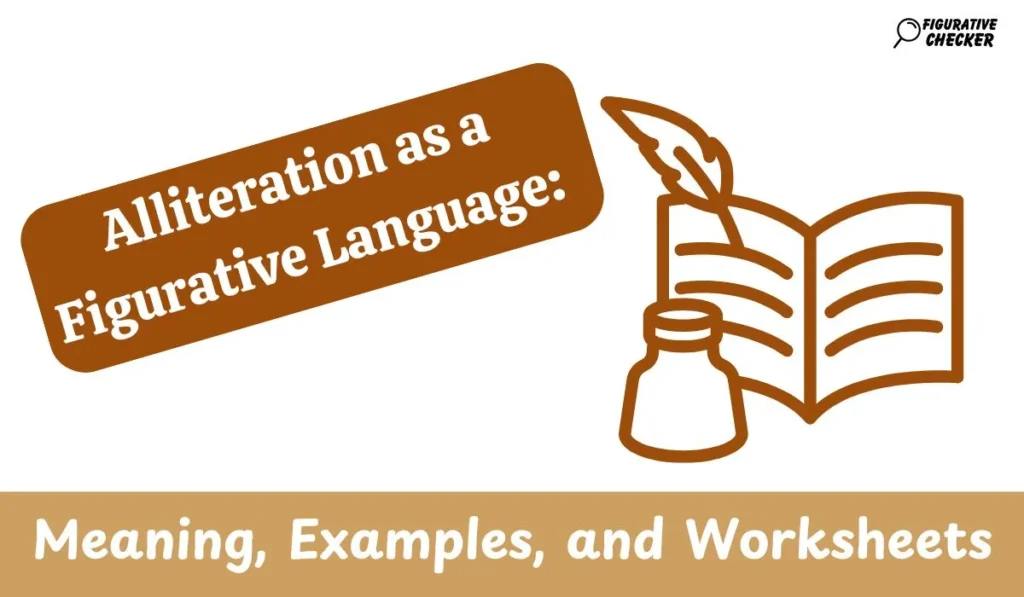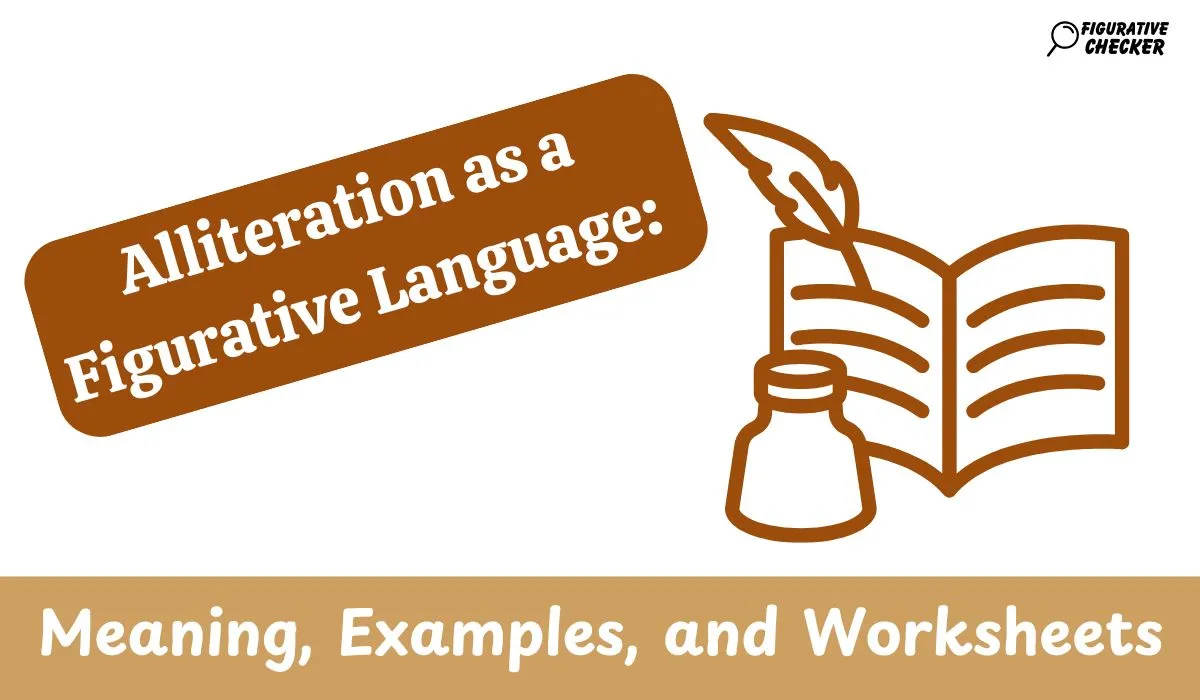
Figurative language enriches communication by adding layers of meaning and creativity to otherwise plain expressions. Among the various types of figurative language, alliteration holds a special place. It engages readers and listeners by creating a rhythmic and often memorable sound pattern. In this comprehensive guide, we’ll explore the definitions, examples, and educational worksheets related to alliteration and other types of figurative language.
What is Alliteration in Figurative Language?
Alliteration is a stylistic literary device where consecutive words in a sentence or phrase begin with the same consonant sound. This repetition creates a pleasing auditory effect, making texts more engaging and memorable.
Alliteration Definition and Examples
To understand alliteration better, here are some examples:
- Classic Literature: “Peter Piper picked a peck of pickled peppers.”
- Advertising: “Dunkin’ Donuts,” “Best Buy,” and “PayPal.”
- Everyday Speech: “Busy as a bee,” or “Curiosity killed the cat.”
In these examples, the repeated initial consonants create a catchy and impactful effect, contributing to the memorability of phrases.
Why Use Alliteration?
Writers, poets, and marketers often use alliteration to achieve the following:
- Emphasize Key Ideas: The repeated sounds draw attention to important words.
- Enhance Rhythm and Flow: Alliteration provides a natural cadence that makes reading or speaking smoother.
- Create Mood and Tone: Depending on the consonant used, alliteration can create a cheerful, somber, or even mysterious atmosphere.
- Memorability: Alliterative phrases are easier to remember, making them effective in branding and marketing.
Alliteration and Figurative Language Types
Alliteration is just one type of figurative language. Understanding how it compares with other forms can deepen one’s appreciation of literary creativity.
Common Types of Figurative Language
- Metaphor: A direct comparison between two unrelated things, implying that one is the other.
- Example: “Her heart is a cold iron.”
- Simile: A comparison using “like” or “as.”
- Example: “He is as brave as a lion.”
- Hyperbole: An intentional exaggeration for emphasis.
- Example: “I’ve told you a million times!”
- Personification: Giving human characteristics to non-human things.
- Example: “The wind whispered through the trees.”
- Onomatopoeia: Words that mimic sounds.
- Example: “The bees buzzed around the garden.”
- Imagery: Descriptive language that appeals to the senses.
- Example: “The fragrance of fresh roses filled the air.”
How Alliteration Complements Other Figurative Language Types
Alliteration can work hand-in-hand with other forms of figurative language to enhance literary works:
- Metaphor and Alliteration: “Silky shadows slithered silently,” combining vivid imagery with repeated sounds.
- Personification and Alliteration: “The wind whistled wildly in the woods.”
Examples of Alliteration in Figurative Language
To further illustrate how alliteration functions in various contexts, let’s explore different categories of examples:
Poetry Examples
- “The fair breeze blew, the white foam flew.” — Samuel Taylor Coleridge
- “Once upon a midnight dreary, while I pondered weak and weary.” — Edgar Allan Poe
Advertising and Branding Examples
- Coca-Cola: Known for catchy slogans often featuring alliteration.
- Brand Slogans: “Finger-lickin’ good” (KFC) and “Melts in your mouth, not in your hand” (M&Ms).
Children’s Literature Examples
- Dr. Seuss’s books frequently use alliteration: “Bartholomew and the Oobleck” and “Fox in Socks.”
Music Lyrics Examples
- “Shake it off, shake it off” — Taylor Swift
- “Whisper words of wisdom, let it be” — The Beatles
Alliteration Worksheets for Educational Use
Incorporating alliteration worksheets into classroom lessons can help students understand and apply this figurative language technique.
Worksheet Ideas
- Alliteration Identification:
- Provide students with a list of sentences and ask them to underline alliterative phrases.
- Example: “Sally sells seashells by the seashore.”
- Creative Writing Task:
- Ask students to write a short poem or story using at least five alliterative phrases.
- Alliteration Brainstorm:
- Provide a letter and ask students to brainstorm as many alliterative phrases as possible.
- Crossword and Matching Games:
- Incorporate vocabulary-building activities using alliteration-focused crossword puzzles.
Alliteration Figurative Language PDF Resources
Educational resources in PDF format can be invaluable for teachers, students, and parents. Some recommended materials include:
- Alliteration Worksheets PDF: Comprehensive worksheets with identification and creative writing tasks.
- Figurative Language Examples PDF: A compilation of various figurative language examples, including alliteration.
- Lesson Plans PDF: Detailed plans for educators to teach alliteration and other types of figurative language.
Conclusion
Alliteration is a powerful figurative language tool that enriches communication, literature, and branding. By understanding its definition, examples, and educational applications, writers and learners can harness its potential to create impactful content. For educators, incorporating worksheets and PDF resources into lessons ensures that students grasp the concept and apply it creatively. Embrace the magic of alliteration and watch your words come alive with rhythm and charm.
Alliteration is a powerful and playful form of figurative language that involves the repetition of consonant sounds at the beginning of words in close proximity. This literary device not only adds rhythm and musicality to writing but also helps emphasize certain ideas, create vivid imagery, or make phrases more memorable. For instance, when describing a hearty meal like the one you’d find on the “Longhorn Steakhouse Hickory Menu,” alliteration can bring out its rich flavors and inviting aromas: “Sizzling steaks seasoned with savory spices satisfy the soul.
” The repeated ‘s’ sound mirrors the sizzle of the grill, drawing readers into an experience filled with warmth and indulgence. To explore this concept further, worksheets designed around examples such as these provide engaging opportunities for learners to practice crafting their own alliterative sentences while appreciating how language enhances even everyday experiences—like enjoying a delicious dish from Longhorn Steakhouse’s Hickory Menu.
FAQs
Q1: What is alliteration in figurative language?
Alliteration is a literary device where consecutive words begin with the same consonant sound, creating a rhythmic and memorable effect.
Q2: How does alliteration enhance writing?
Alliteration makes writing more engaging, and memorable and often adds a pleasing rhythm to the text.
Q3: Can alliteration be used in professional writing?
Yes, alliteration is often used in marketing, branding, and speechwriting to capture attention and make messages more memorable.
Q4: Are there any educational worksheets for alliteration?
Yes, various worksheets are available that help students identify and create alliterative phrases.
Q5: How does alliteration compare to other figurative language types?
While alliteration focuses on sound repetition, other figurative language types such as metaphors and similes focus on comparisons, and personification attributes human characteristics to non-human entities.
